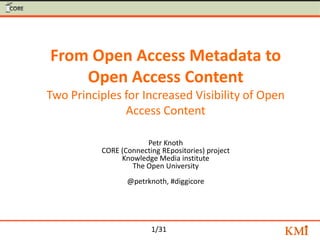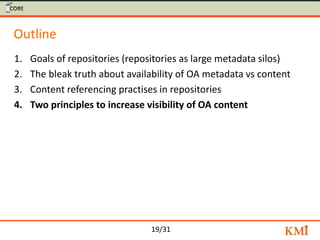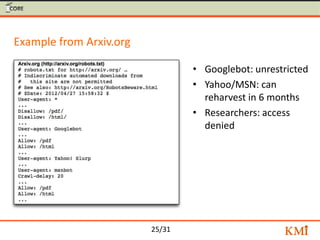1. The document discusses two principles for increasing the visibility of open access content by moving from just open access metadata to open access content.
2. The first principle is that repositories should always provide a link in the metadata from each record to the full content item. This ensures the content is discoverable and accessible.
3. The second principle is that repositories should provide universal access to machines to harvest and index the full content, similar to the level of access provided to humans, in order to fully realize the benefits of open access such as reuse and text mining.






![7/31
COAR: About harvesting and aggregations …
“Each individual repository is of limited value for research: the real
power of Open Access lies in the possibility of connecting and tying
together repositories, which is why we need interoperability. In
order to create a seamless layer of content through connected
repositories from around the world, Open Access relies on
interoperability, the ability for systems to communicate with each
other and pass information back and forth in a usable format.
Interoperability allows us to exploit today's computational power so
that we can aggregate, data mine, create new tools and services,
and generate new knowledge from repository content.’’
[COAR manifesto]](https://image.slidesharecdn.com/knoth-presentation-130709121211-phpapp02/85/From-Open-Access-Metadata-to-Open-Access-Content-Two-Principles-for-Increased-Visibility-of-Open-Access-Content-7-320.jpg)




![12/31
“[The institutional repository] is like a roach motel. Data goes in, but
it doesn’t come out.” (Salo, 2008)](https://image.slidesharecdn.com/knoth-presentation-130709121211-phpapp02/85/From-Open-Access-Metadata-to-Open-Access-Content-Two-Principles-for-Increased-Visibility-of-Open-Access-Content-12-320.jpg)

















![30/31
References 1/2
[BOAI, 2002] Budapest Open Access Initiative. (2002)
http://www.opensocietyfoundations.org/openaccess/boai-10-recommendations
[Crow, 2002] Crow, R. (2002). The case for institutional repositories: a SPARC position
paper. ARL Bimonthly Report 223.
[Knoth & Zdrahal, 2012] Knoth, P. and Zdrahal, Z. (2012) CORE: Three Access Levels to
Underpin Open Access, D-Lib Magazine, 18, 11/12, Corporation for National Research
Initiatives, http://dx.doi.org/10.1045/november2012-knoth
[Konkiel, 2012] Konkiel, S. (2012) Are Institutional Repositories Doing Their Job?
https://blogs.libraries.iub.edu/scholcomm/2012/09/11/are-institutional-repositories-
doing-their-job/
[Laakso & Bjork, 2012] Laakso, M., & Björk, B. C. (2012). Anatomy of open access
publishing: a study of longitudinal development and internal structure. BMC Medicine,
10(1), 124.](https://image.slidesharecdn.com/knoth-presentation-130709121211-phpapp02/85/From-Open-Access-Metadata-to-Open-Access-Content-Two-Principles-for-Increased-Visibility-of-Open-Access-Content-30-320.jpg)
![31/31
References 2/2
[Morrison, 2012] Morrison, Louise (2012) 5 reasons why I can’t find Open Access
publications. http://mmitscotland.wordpress.com/2012/08/06/5-reasons-why-i-cant-find-
open-access-publications-2/
[OAI-PMH v2.0, 2008] The Open Archives Initiative Protocol for Metadata Harvesting
Version 2.0 (OAI-PMH), Impementation Guidelines (2008).
http://www.openarchives.org/OAI/openarchivesprotocol.html
[ResourceSync draft, 2013] ResourceSync protocol draft. 2013
http://www.niso.org/workrooms/resourcesync/
[Salo, 2008] Salo, D. (2008). Innkeeper at the roach motel. Library Trends, 57(2), 98-123.
[Van de Sompel et al, 2004] Van de Sompel, H., Nelson, M. L., Lagoze, C., & Warner, S.
(2004). Resource harvesting within the OAI-PMH framework. D-lib magazine, 10(12), 1082-
9873.](https://image.slidesharecdn.com/knoth-presentation-130709121211-phpapp02/85/From-Open-Access-Metadata-to-Open-Access-Content-Two-Principles-for-Increased-Visibility-of-Open-Access-Content-31-320.jpg)